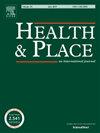Place-based Opportunities and Physiological Stress: Understanding Neighborhood-level Disparities in Allostatic Load
IF 4.1
2区 医学
Q1 PUBLIC, ENVIRONMENTAL & OCCUPATIONAL HEALTH
引用次数: 0
Abstract
Background
Allostatic load, representing cumulative physiological stress, is linked to various health outcomes. While neighborhood conditions influence health, the relationship between comprehensive neighborhood opportunity measures and allostatic load remains understudied.
Methods
Using data from 2118 participants in the Midlife in the United States study, we examined associations between neighborhood opportunity (measured by the Childhood Opportunity Index) and allostatic load (measured using standard clinical cut-offs of eight biomarkers: systolic and diastolic blood pressure, hemoglobin A1C, high-density lipoprotein cholesterol, body mass index, waist circumference, total cholesterol, and c-reactive protein). The index comprised three subdomains: Education, Health and Environment, and Social and Economic Resources. Negative binomial regression models quantified these associations, adjusting for sociodemographic characteristics, health behaviors, and prescribed medication use.
Results
Lower Overall Neighborhood Opportunity was significantly associated with higher allostatic load, even after full covariate adjustment (18 % increase in expected allostatic load count, 95 % CI: 8 %–29 %, p < 0.001). Social and Economic Resources emerged as the subdomain that consistently tracked with expected allostatic load count. Negative binomial regression models provided evidence of similar significant patterns across the Education and Health and Environment models when comparing low to high groups.
Conclusions
Low neighborhood opportunity is associated with increased physiological stress as measured by allostatic load. These findings further indicate that neighborhood-level interventions may be crucial for reducing health inequities and improving population health outcomes.
基于地点的机会和生理应激:了解适应负荷的邻里水平差异
背景:适应负荷代表累积的生理应激,与各种健康结果有关。虽然社区条件影响健康,但综合社区机会措施与适应负荷之间的关系仍未得到充分研究。方法使用来自2118名美国中年研究参与者的数据,我们检查了邻里机会(通过儿童机会指数测量)和适应负荷(使用8个生物标志物的标准临床截止值测量:收缩压和舒张压、血红蛋白A1C、高密度脂蛋白胆固醇、体重指数、腰围、总胆固醇和c反应蛋白)之间的关系。该指数包括三个子领域:教育、卫生和环境以及社会和经济资源。负二项回归模型量化了这些关联,调整了社会人口统计学特征、健康行为和处方药使用。结果较低的总体邻里机会与较高的适应负荷显著相关,即使在完全协变量调整后也是如此(预期适应负荷增加18%,95% CI: 8% - 29%, p <;0.001)。社会和经济资源作为子领域出现,始终跟踪预期的适应负荷计数。负二项回归模型提供的证据表明,在比较低群体和高群体时,整个教育和健康与环境模型都存在类似的显著模式。结论慢邻里机会与适应负荷测量的生理应激增加有关。这些发现进一步表明,社区一级的干预措施可能对减少卫生不平等和改善人口健康结果至关重要。
本文章由计算机程序翻译,如有差异,请以英文原文为准。
求助全文
约1分钟内获得全文
求助全文
来源期刊

Health & Place
PUBLIC, ENVIRONMENTAL & OCCUPATIONAL HEALTH-
CiteScore
7.70
自引率
6.20%
发文量
176
审稿时长
29 days
期刊介绍:
he journal is an interdisciplinary journal dedicated to the study of all aspects of health and health care in which place or location matters.
 求助内容:
求助内容: 应助结果提醒方式:
应助结果提醒方式:


